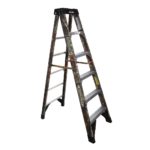
Ladders are familiar job site and around the house tools that provide access to difficult-to-reach locations. Choosing the right ladder for the job at hand and placing it properly prevents accidents and lets you work efficiently. Ladder safety is simple when you follow a few basic usage guidelines.
Ladder safety begins with picking the right tool for the job.
Free-standing step ladders require no additional support and are ideal for reaching high points in interior spaces. Extension or straight ladders lean against a wall or other solid surface. They’re commonly used to gain access to roofs or second and third-story walls. You can use many portable or multi-position ladders as either a step ladder or a straight ladder, making these tools an excellent choice for homeowners with limited storage space.
Once you’ve chosen a ladder, inspect it to ensure all joints are secure and the rungs are free of dirt or liquids that could affect footing. Check its rated weight capacity to make sure it’s robust enough to handle the task. Extension or step ladder safety depends on having a tool that’s the right size for the job. Extension ladders should reach at least three feet above the top support point to provide safe access to elevated areas, and a step ladder should be tall enough to put the work area within easy reach without standing on the ladder’s top rung.
Getting to the Job
Proper ladder safety includes getting your tools to the site. When transporting ladders on a vehicle, secure them properly using a ladder rack and mark any that extend beyond the ends of your truck or car with a bright flag to alert other drivers to the potential hazard. Once you reach the job site, use two people to move long ladders to prevent damage to walls and keep others safe.
Safe Ladder Placement
 There are a few guidelines for placement that enhance step, portable and extension ladder safety. Check for power lines before you place your ladder, and if you must work near electrical equipment, don’t use a metal ladder. Avoid blocking doors or walkways, and block off or guard the work area to prevent accidents. All ladder feet should be on a solid, level and flat surface, and rungs should be parallel to the ground when the ladder is in place. Never position a ladder on top of other objects to extend its reach. Fully engage ladder hinges, spreaders and locking devices before climbing. This is especially important for portable ladder safety since these tools often have multiple hinges that all must be locked in place before climbing.
There are a few guidelines for placement that enhance step, portable and extension ladder safety. Check for power lines before you place your ladder, and if you must work near electrical equipment, don’t use a metal ladder. Avoid blocking doors or walkways, and block off or guard the work area to prevent accidents. All ladder feet should be on a solid, level and flat surface, and rungs should be parallel to the ground when the ladder is in place. Never position a ladder on top of other objects to extend its reach. Fully engage ladder hinges, spreaders and locking devices before climbing. This is especially important for portable ladder safety since these tools often have multiple hinges that all must be locked in place before climbing.
When it comes to extension ladder safety, there are a few additional placement requirements. Place the base of the ladder so the horizontal distance between the top and bottom support points is about one-quarter the ladder’s working length. If work activities may displace the ladder, secure it in place.
Safe Climbing Techniques
Before setting foot on the first rung, make sure you’re ready to climb. Wear work shoes with heavy, skid-resistant soles, and make sure they’re clean. Never use a ladder if you feel dizzy or fatigued, and avoid climbing in high winds or during storms. Use a tool belt to carry supplies, and keep three points of contact with the ladder at all times. Once you’re in position, lift additional materials to the work area with a towline, and use ladder accessories such as trays and paint buckets to hold supplies. As you work, keep your center of mass over the ladder to avoid tipping. A good ladder safety rule of thumb is to keep your belt buckle between the ladder rails.
 Ladders are an excellent tool for getting to hard to reach spaces. This ladder safety checklist summarizes what you need to know to use these tools correctly:
Ladders are an excellent tool for getting to hard to reach spaces. This ladder safety checklist summarizes what you need to know to use these tools correctly:
- Match the ladder to the job, and make sure it’s long enough to reach the work area.
- Inspect your ladder to ensure it’s clean and in good shape.
- Transport ladders to and around the job site safely.
- Check for power lines or overhead hazards before setting up your ladder.
- Place your ladder on a flat and solid surface and at a proper angle.
- Keep ladders away from doors or walkways.
- Allow only one person to climb at a time, unless the ladder is specifically designed to handle multiple climbers.
- Keep your center of mass over the ladder,and maintain three points of contact as you climb.
- Avoid using ladders in high winds or during storms.
Choose the right ladder, place it correctly and use the proper climbing technique to reach any work area and complete the task safely.





One Comment
Jocelyn McDonald
March 8, 2019 at 7:47 amMy husband considers himself a bit of a handyman, and he recently told me we wants to get a ladder so he can continue making fixes around the house. Your article had some great tips my husband can use to stay safe when he does get a ladder, and I liked how you said that when getting something like this, my husband might consider a portable or multi-position ladders as either a step ladder or a straight ladder, which are great for homeowners with limited storage space. Thanks; I’ll share this with my husband to help him choose and use a ladder.